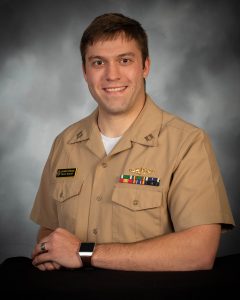
Ben McFarland was inspired by the good teachers he had as a student at Iowa State University and now he’s looking to pay it forward in his capacity as a college instructor.
McFarland grew up in Nevada, Iowa and developed an interest in STEM at an early age because of his father, Pat, who worked as a control systems engineer for 3M in Ames.
“Hearing him talk about the things he would do for work was just really interesting to me as a kid,” McFarland said.
The younger McFarland knew he wanted to pursue engineering studies at Iowa State University, but he was less certain about the particular field of engineering he would pursue. He started off in electrical engineering before transferring to chemical engineering and he even had a brief stint as a business major, before settling on mechanical engineering (ME). Specifically, McFarland said he liked that ME focused on methods like energy generation and conversion as well as machine design. To learn even more about the energy side, McFarland decided to also pick up a minor in nuclear engineering. (The nuclear engineering minor program at Iowa State was discontinued in 2018.)
“I’m a big fan of the outdoors and part of that for me is conserving the outdoors,” said McFarland. “We still need a form of clean energy that can consistently provide our baseline needs and nuclear provides that.”
McFarland was able to apply the material he learned in the classroom to internships he had with Lennox, ConAgra and 3M. Wanting to serve his country in a technical capacity, McFarland applied for and was accepted to the Navy’s Nuclear Propulsion Officer Candidate (NUPOC) program. This set him up to serve on board a submarine after finishing college
McFarland completed his B.S. in ME in Spring 2014 and then moved to Newport, R.I. to attend Officer Candidate School. He then moved back to the Ames area to do recruiting for the Navy. He often visited classrooms, where he was a student just a few months prior, to recruit new members to the NUPOC program.
After his short stint in recruiting, he moved to Charleston, S.C. to learn about how navy nuclear propulsion plants operate. After learning the material in a classroom setting, he and the other candidates then had the opportunity to apply what they learned by operating nuclear propulsion components on a decommissioned ship.
McFarland then spent three years learning how to operate submarines out of Groton, Conn. Once this stint was completed, he had to decide if he would attend the Naval Postgraduate School in Monterey, Calif. or if he would return to civilian life. He chose the former and completed his M.S. in ME in 2020.
Since then, he has served as a senior instructor at the U.S. Naval Academy in Annapolis, Md., where he teaches Principles of Naval Engineering: Propulsion and Auxiliary Systems. The course covers methods like propulsion, hydraulics, refrigeration, incompressible fluid flows and energy generation from sources like steam, nuclear, reciprocating internal combustion engine and gas turbine engines. McFarland jokes that his course is “an inch deep, but a mile wide.” He said that the biggest challenge of his job is teaching engineering concepts to non-engineers since his course is a requirement for all Naval Academy non-engineering students. (All students who complete undergraduate studies at the Academy receive a B.S. degree whether their program is in a STEM field or the humanities/social sciences.)
“They probably feel how I did taking English and other gen ed courses,” McFarland said with a laugh. “But most of them are very motivated and it’s clear to me they’re making a genuine effort to learn the material.”
To help his students, many of whom do not consider STEM within their forte, grasp the difficult concepts, McFarland draws on his time as a student at Iowa State University.
“What I enjoyed most at ISU was when a lab correlated closely with what we just learned in lecture. Now as an instructor I understand how we try to reinforce that conceptual content with hands-on activities or experiential learning. Nothing is more rewarding than when you see that light bulb go off in a student’s head after they learn something new,” McFarland said.
McFarland said he is often using material and even teaching techniques he learned as an undergraduate at Iowa State through courses such as thermodynamics with Mathew Hagge, fluid mechanics with Terrence Meyer (now at Purdue University) and senior capstone with Gloria Starns, whom he still remains in contact with today. McFarland added that he also learned a lot from the nuclear engineering courses he took with Greg Maxwell (now retired).
Outside of work, McFarland likes to go camping, specifically at state and national parks, with his wife, Patty, and children: Evie, 4, and Millie, 1. Reflecting back on his time at Iowa State, McFarland cites the now defunct VEISHEA event as one his favorite memories. He also fondly remembers playing bass guitar for The Green Light District, a group he founded with his friends which performed in the Ames area and covered songs from artists like Tom Petty, Cheap Trick, the Rolling Stones and the Red Hot Chili Peppers.